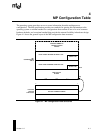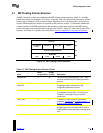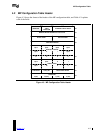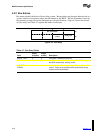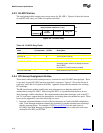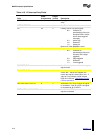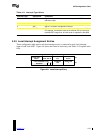
MultiProcessor Specification
4-8 Version 1.4
Table 4-4. Processor Entry Fields
Field
Offset
(in bytes:bits)
Length
(in bits) Description
ENTRY TYPE 0 8 A value of 0 identifies a processor entry.
LOCAL APIC ID 1 8 The local APIC ID number for the particular
processor.
LOCAL APIC VERSION # 2 8 Bits 0–7 of the local APIC’s version register.
CPU FLAGS: EN 3:0 1 If zero, this processor is unusable, and the
operating system should not attempt to access this
processor.
CPU FLAGS: BP 3:1 1 Set if specified processor is the bootstrap
processor.
CPU SIGNATURE:
STEPPING 4:0 4 Refer to Table 4-5 for values.
MODEL 4:4 4 Refer to Table 4-5 for values.
FAMILY 5:0 4 Refer to Table 4-5 for values.
FEATURE FLAGS 8 32 The feature definition flags for the processor as
returned by the CPUID instruction. Refer to
Table 4-6 for values. If the processor does not
have a CPUID instruction, the BIOS must assign
values to FEATURE FLAGS according to the
features that it detects.
The configuration table is filled in by the BIOS after it executes a CPU identification procedure on
each of the processors in the system. Whenever possible, the complete 32-bit CPU signature
should be filled with the values returned by the CPUID instruction. The CPU signature includes
but is not limited to, the stepping, model, and family fields. If the processor does not have a
CPUID instruction, the BIOS must fill these and future reserved fields with information returned
by the processor in the EDX register after a processor reset. See the Pentium
Processor User’s
Manual and Intel Processor Identification with the CPUID Instruction (AP-485) for details on the
CPUID instruction.




